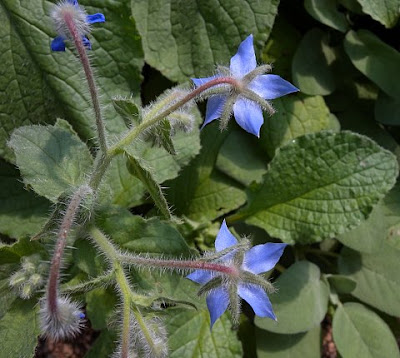Borage attracts many beneficial insects.
Common Name: Borage
Other Names: Starflower, Bee Bush, Bee Bread, Bugloss
Scientific Name: Borago officinalis
Scientific Name: Borago officinalis
Family: Boraginaceae (the Borage or Forget-Me-Not family)
Borage is an annual that can be used as a perennial.
Description:
While Borage may be a rather scrubby plant (covered in a light fuzz that turns to stiff prickly hairs as the plant matures), its brilliant blue flowers more than make up for it. It is an annual plant, but it reseeds so easily that it can almost be considered a perennial. The leaves and edible flowers have a cucumber-like flavor, it has a deep taproot that breaks up hard-packed soil, the flowers provide nectar to beneficial insects, and the fuzzy leaves are a favorite hang-out of beneficial pest predators for the garden. Borage is a great addition to a Forest Garden.
Borago officinalis
History:
Originating from Syria, this annual herb is now naturalized through Europe, Asia, North Africa, and South America.
Trivia:
- Borage was once used to flavor wine.
- Borage was historically used to give men courage.
Borage filled ravioli
Recipe can be found here: http://blog.cookitaly.com/2010/03/borage-filled-ravioli.html
USING THIS PLANT
Primary Uses:
- Leaves - light cucumber flavor; fresh or cooked (can be added to soups, pastas, sauces, or used as a cooked green, also reportedly used in jellies and lemonades)
- Flowers - light cucumber flavor; fresh use in salads, as an edible garnish in soups, added to Summer time mixed drinks (Gin is most common), frozen in ice cubes for drinks, used in teas, and even candied (beautiful edible garnish for cakes), can also be dried for decorative uses
- Seeds - pressed for oil; commercially raised for this... used as a supplement, not a cooking oil
Secondary Uses:
- General insect (especially bees) nectar plant
- Host plant for lacewings to lay eggs
- Favorite plant for beneficials (spiders, damsel bugs, ground beetles, parasitoid wasps)
- Reportedly a great companion plant for tomatoes, squash, and strawberries
- Deep rooted green manure - can help break up hard packed soils... great addition to seed balls
- Traditional medicinal uses
Borage is not a large plant.
Harvesting: Flowers at any time. Leaves are best picked young before the fuzzy hairs develop.
Storage: Flowers best if used shortly after picking. Leaves are best if used within a few days of harvest if stored in a cool place.
Young leaves (before the fuzz develops) are the best for eating.
DESIGNING WITH THIS PLANT
USDA Hardiness Zone: Annual, so not really applicable
AHS Heat Zone: No reliable information is available
Chill Requirement: Likely, as it is a flowering plant, although based on from where it originates, the chill requirement is probably low; however, no reliable information is available
Plant Type: Self-seeding, straggly, clumping annual
Leaf Type: Annual
Forest Garden Use: Herbaceous Layer
Cultivars/Varieties: Many varieties available, although few are named.
Pollination: Self-Pollinating/Self-Fertile
Flowering: May-September (late Spring through late Summer)
Life Span: 1 year as this is an annual, but functionally can be treated as an indefinate life span as it so readily re-seeds.
PHYSICAL CHARACTERISTICS OF THIS PLANT
Size: 1-2 feet (30-60 centimeters) tall and 1 foot (30 cm) wide - clumping nature
Roots: Deep taproot
Growth Rate: Fast
GROWING CONDITIONS FOR THIS PLANT
Light: Prefers full sun
Shade: Tolerates light shade
Moisture: Medium
pH: most species prefer fairly neutral soil (6.1 - 7.0)
Special Considerations for Growing:
This plant is easily blown over. Consider growing in a wind protected spot or plant them close together so they support each other.
Propagation: Easily from seed. Seed typically sown April - May. Best if direct seeded.
Maintenance: None
Concerns: Can be very dispersive via seed; however, I see this as a beneficial plant, not an invasive one... I would encourage its spread.
Borage has beautiful edible flowers.










No comments:
Post a Comment